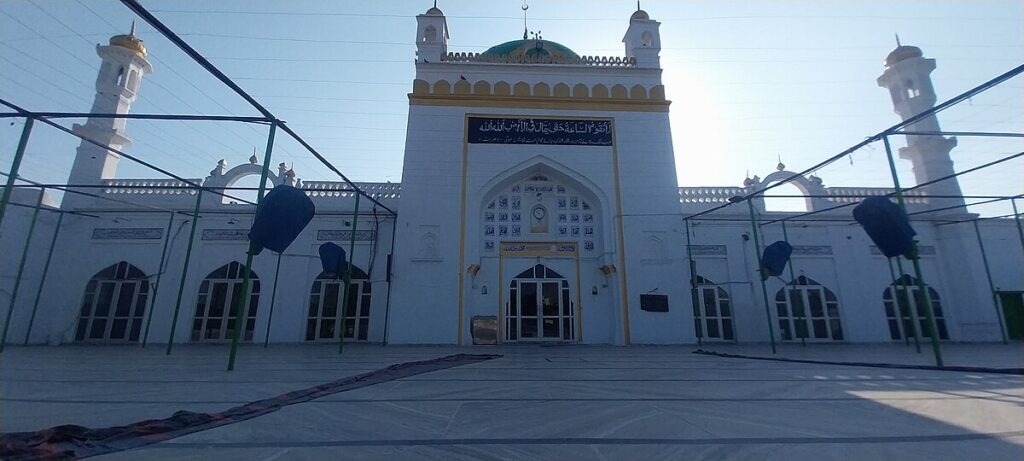The Allahabad High Court has officially referred to the Shahi Jama Masjid in Sambhal as a “disputed structure,” intensifying the ongoing legal dispute over the site’s historical and religious significance. This designation came during a hearing on a petition filed by the mosque’s management committee, which sought permission to whitewash the Mughal-era mosque. The court’s decision aligns with the demands of the Hindu petitioners, who assert that the mosque was constructed over a demolished Hindu temple.
The controversy centers on claims that the 16th-century Shahi Jama Masjid was built atop the ruins of a Hindu temple allegedly destroyed by Mughal emperor Babur. These allegations have led to heightened tensions between Hindu and Muslim communities in the region. In response to a petition from the mosque committee requesting authorization for whitewashing, the court considered objections from the Hindu side, represented by advocate Hari Shankar Jain. Jain contended that any structure involved in a legal dispute should not be designated as a mosque or any other entity until a final court verdict is delivered. He further argued that the responsibility for the mosque’s maintenance lies with the Archaeological Survey of India , not the mosque committee, citing unauthorized alterations to the structure.
The court concurred with Jain’s argument and instructed the stenographer to refer to the Shahi Jama Masjid as a “disputed structure” in official records. This decision underscores the court’s recognition of the site’s contentious status and reflects the ongoing legal proceedings concerning its ownership and historical background.
The legal battle over the Shahi Jama Masjid has been marked by significant unrest. In November 2024, a court-ordered ASI survey to investigate the claims regarding the mosque’s origins led to violent clashes in Sambhal. Protests erupted as nearly 1,000 Muslims gathered to oppose the survey, resulting in confrontations with the police that left five people dead and several others injured. The violence prompted authorities to close schools and suspend internet services in the area to restore order.
The ASI’s involvement has been a focal point in the dispute. The agency reported unauthorized modifications to the mosque’s structure, including changes to tiles and stones, and the application of thick enamel paint allegedly covering the original surface. These alterations have raised concerns about the preservation of the site’s historical integrity. In response, the High Court ordered a comprehensive survey of the mosque to assess the extent of these changes and determine the appropriate course of action.
The Hindu petitioners have drawn parallels between the Shahi Jama Masjid case and the long-standing Ayodhya dispute, where the Babri Masjid-Ram Mandir site was referred to as a “disputed structure” for decades during legal proceedings. They argue that similar terminology should be applied to the Sambhal mosque until a final verdict is reached. This perspective highlights the sensitivity surrounding such disputes and the potential implications for communal harmony.
The mosque committee, on the other hand, maintains that it holds responsibility for the mosque’s upkeep under a 1927 agreement. However, this claim has been contested by the Hindu petitioners, who assert that the ASI should oversee the site’s maintenance to prevent any unauthorized alterations that could affect the ongoing legal proceedings.
The court’s recent decision to label the Shahi Jama Masjid as a “disputed structure” adds a new dimension to the legal battle, potentially influencing future proceedings and the management of the site. The designation may also impact the ASI’s role in preserving the mosque’s historical features, as any further modifications could be subject to stricter scrutiny.
The situation in Sambhal remains tense, with both communities closely monitoring developments. Authorities have increased security measures around the mosque to prevent any escalation of violence. Community leaders from both sides have called for restraint and emphasized the importance of resolving the dispute through legal channels to maintain peace and communal harmony.
As the legal proceedings continue, the focus will be on the ASI’s forthcoming comprehensive survey report, which is expected to shed light on the extent of the structural alterations and their implications for the site’s historical authenticity. This report will likely play a crucial role in the court’s future decisions regarding the Shahi Jama Masjid and its designation as a “disputed structure.”




 The Left Can Win Elections In Europe Without Immigration Restrictionism
The Left Can Win Elections In Europe Without Immigration Restrictionism 